Maryland is home to various woodpecker species, each contributing to the state’s rich avian tapestry. Six distinct types of woodpeckers can be found across Maryland’s woodlands and forests, showcasing nature’s fascinating variations.
These vibrant birds, characterized by their distinctive drumming and pecking sounds, play crucial roles in maintaining ecological balance by foraging for insects and larvae hidden within tree bark.
Among Maryland’s woodpecker residents are the iconic Pileated Woodpecker, with its striking red crest, and the Downy Woodpecker, a smaller yet equally charming species.
Exploring the unique characteristics and habits of these six woodpecker types reveals the interconnectedness of Maryland’s ecosystems and the captivating beauty of its avian inhabitants.
Is Maryland A Good Place for Woodpeckers?
Yes, Maryland is indeed a favorable habitat for woodpeckers. The state’s diverse landscape, consisting of woodlands, forests, and suburban areas with mature trees, provides an ideal environment for various woodpecker species.
Maryland’s woodpecker-friendly features include:
Rich Biodiversity
Maryland’s varied ecosystems support a wide range of insect species, which serve as a primary food source for woodpeckers. The abundance of insects in trees and woodlands attracts woodpeckers, contributing to their well-being.
Mature Trees
Many woodpecker species prefer mature trees for nesting and foraging. Maryland’s landscape includes extensive stands of mature hardwood and mixed forests, offering suitable habitats with old trees that are conducive to woodpecker activities.
Suburban Areas
Some woodpecker species, like the Red-bellied Woodpecker, adapt well to suburban and residential areas with mature trees.
This adaptability allows them to thrive in various environments across the state, including parks and neighborhoods.
Diverse Woodpecker Species
Maryland hosts a variety of woodpecker species, including the iconic Pileated Woodpecker, the colorful Red-headed Woodpecker, and the smaller Downy Woodpecker. The presence of diverse species reflects the state’s ecological richness.
Conservation Efforts
Conservation initiatives in Maryland, including preserving natural habitats and protecting mature trees, contribute to the overall well-being of woodpecker populations.
Maryland’s combination of natural landscapes and human-inhabited areas with suitable trees makes it a favorable and diverse environment for woodpeckers.
Observing these birds in Maryland gives nature enthusiasts a glimpse into the intricate balance of ecosystems within the state.
6 Woodpeckers of Maryland
Maryland hosts six captivating woodpecker species, each contributing its own flair to the state’s natural landscape.
From the majestic Pileated Woodpecker to the petite Downy Woodpecker, these birds enrich Maryland’s forests with their vibrant colors and rhythmic drumming.
1. Downy Woodpecker
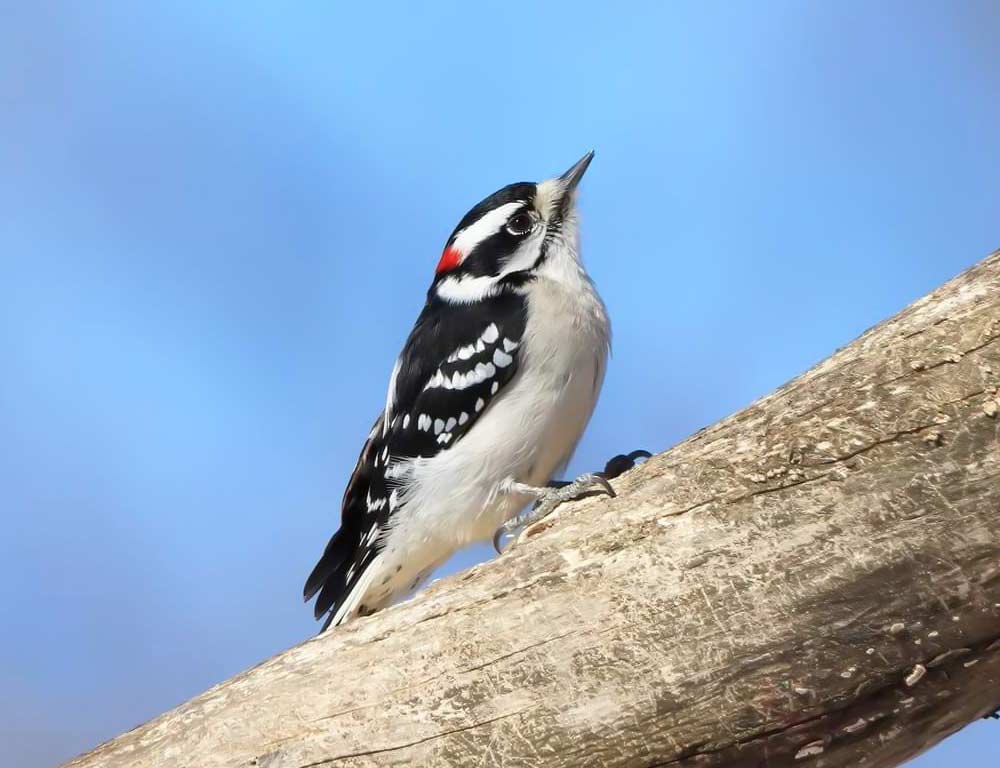
- Scientific Name: Picoides pubescens
- Population: Common and widespread
- Life Span: Up to 11 years
- Size: 6-7 inches
- Weight: 0.7-1.0 ounces
- Food: Insects, seeds, berries
- Wingspan: 9-12 inches
- Status: Stable
The Downy Woodpecker, the smallest in Maryland, is ubiquitous in woodlands and backyards. With distinctive black and white markings, they navigate tree trunks and branches with agility.
These birds primarily feed on insects, especially wood-boring beetles and caterpillars, making them beneficial for tree health. Additionally, they consume seeds and berries, displaying dietary versatility.
Known for their rhythmic drumming, Downy Woodpeckers establish territory and communicate with others using distinct tapping sounds.
They excavate cavities in dead trees or limbs for nesting, demonstrating adaptability to various habitats. Despite their diminutive size, Downy Woodpeckers boast a remarkable lifespan of up to 11 years.
Their stable population status reflects their resilience in the face of changing environments. Observing these charming woodpeckers provides a window into the intricate dynamics of Maryland’s ecosystems.
2. Pileated Woodpecker
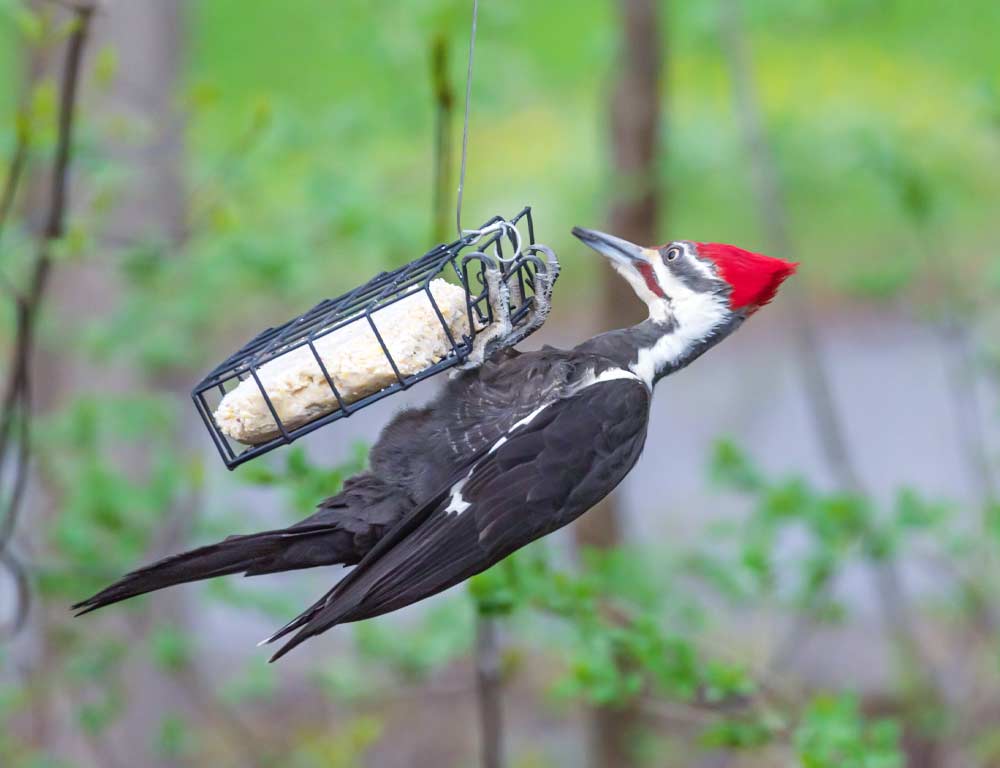
- Scientific Name: Dryocopus pileatus
- Population: Stable but localized
- Life Span: Up to 12 years
- Size: 16-19 inches
- Weight: 8-12 ounces
- Food: Insects, fruits, nuts
- Wingspan: 26-30 inches
- Status: Least Concern
The Pileated Woodpecker, an iconic Maryland resident, is renowned for its striking appearance and impressive size.
These woodpeckers leave a lasting impression with bold black and white plumage and a vibrant red crest. Their large size, with a wingspan of 26-30 inches, distinguishes them from other woodpecker species.
Pileated Woodpeckers primarily forage for insects beneath tree bark, using their powerful bills to excavate sizable holes. Their diet extends to fruits and nuts, showcasing dietary diversity.
Despite their considerable weight, ranging from 8-12 ounces, these birds are agile fliers, easily navigating forested areas. These woodpeckers are known for excavating extensive cavities for nesting, contributing to the overall health of woodland ecosystems.
With a lifespan of up to 12 years, Pileated Woodpeckers play a vital role in maintaining insect populations and shaping the biodiversity of Maryland’s forests.
3. Red-headed Woodpecker
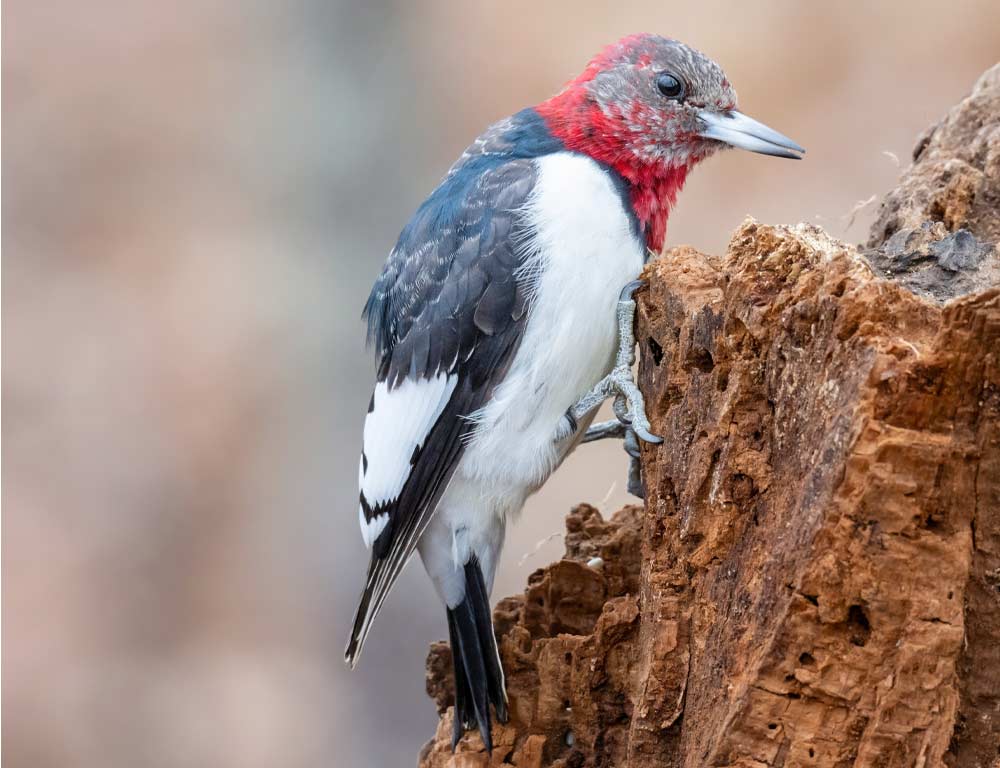
- Scientific Name: Melanerpes erythrocephalus
- Population: Declining
- Life Span: Up to 9 years
- Size: 7.5-9.1 inches
- Weight: 2.0-3.2 ounces
- Food: Insects, fruits, seeds
- Wingspan: 16.5-17.7 inches
- Status: Near Threatened
The Red-headed Woodpecker, distinguished by its vibrant plumage, faces a declining population in Maryland. These birds are easily recognizable with striking redheads, wings, and tails.
Unfortunately, their numbers are diminishing due to habitat loss and competition for nesting sites.
Red-headed Woodpeckers exhibit diverse feeding habits, consuming insects, fruits, and seeds. Their acrobatic flight and keen hunting skills make them efficient insectivores.
Despite being smaller in size, ranging from 7.5 to 9.1 inches, they have a wingspan of 16.5 to 17.7 inches, allowing them to cover significant distances in search of food.
Known for their unique behavior of storing surplus food in tree crevices or impaling it on thorns, Red-headed Woodpeckers play a crucial role in seed dispersal.
Their decline highlights the importance of conservation efforts to preserve their habitats and support their continued existence in Maryland’s ecosystems.
4. Red-bellied Woodpecker
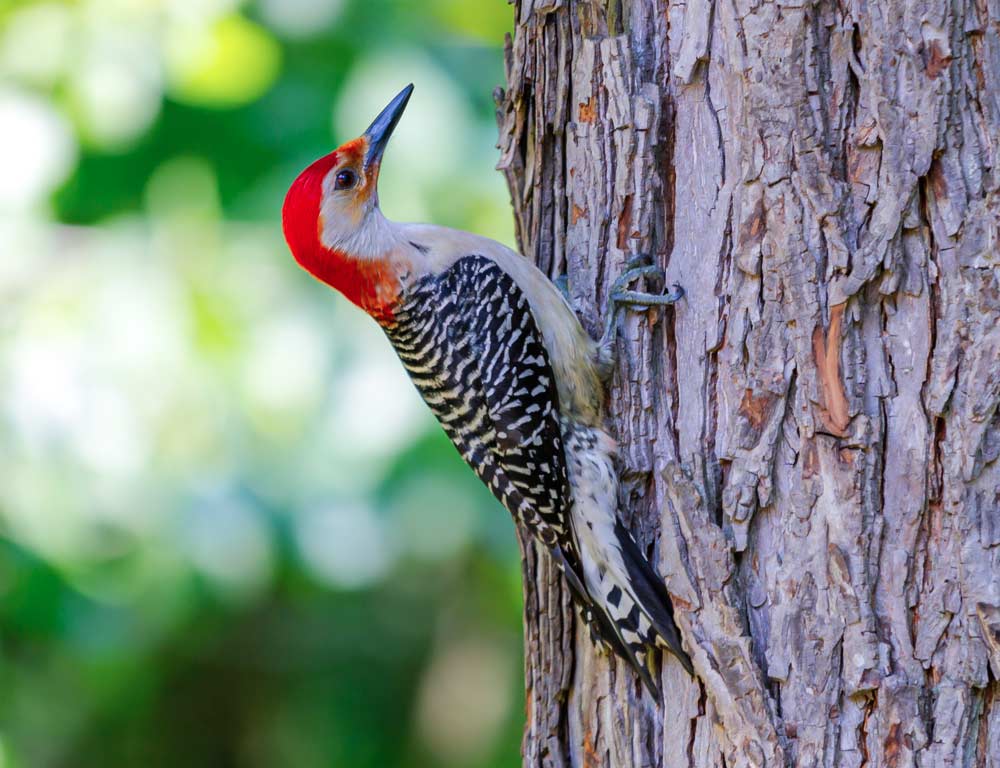
- Scientific Name: Melanerpes carolinus
- Population: Common and increasing
- Life Span: Up to 9 years
- Size: 9-10.5 inches
- Weight: 2-3.2 ounces
- Food: Insects, fruits, seeds, and nuts
- Wingspan: 13-16 inches
- Status: Least Concern
Despite its name, the Red-bellied Woodpecker often has only a faint red tinge on its belly.
It is a familiar sight in Maryland’s woodlands and suburban areas, with distinctive zebra-like patterns on its back and a crimson crown. Their population is on the rise, reflecting their adaptability to various habitats.
These woodpeckers have a diverse diet, including insects, fruits, seeds, and nuts. Their strong bills allow them to extract insects from tree bark and forage for various food sources.
With a size ranging from 9-10.5 inches and a wingspan of 13-16 inches, Red-bellied Woodpeckers exhibit efficient flight patterns and are often heard before they are seen.
Known for their cavity-nesting habits, they often reuse and refurbish old nest sites. Their resilience and adaptability make them integral contributors to the ecological balance in Maryland.
5. Northern Flicker
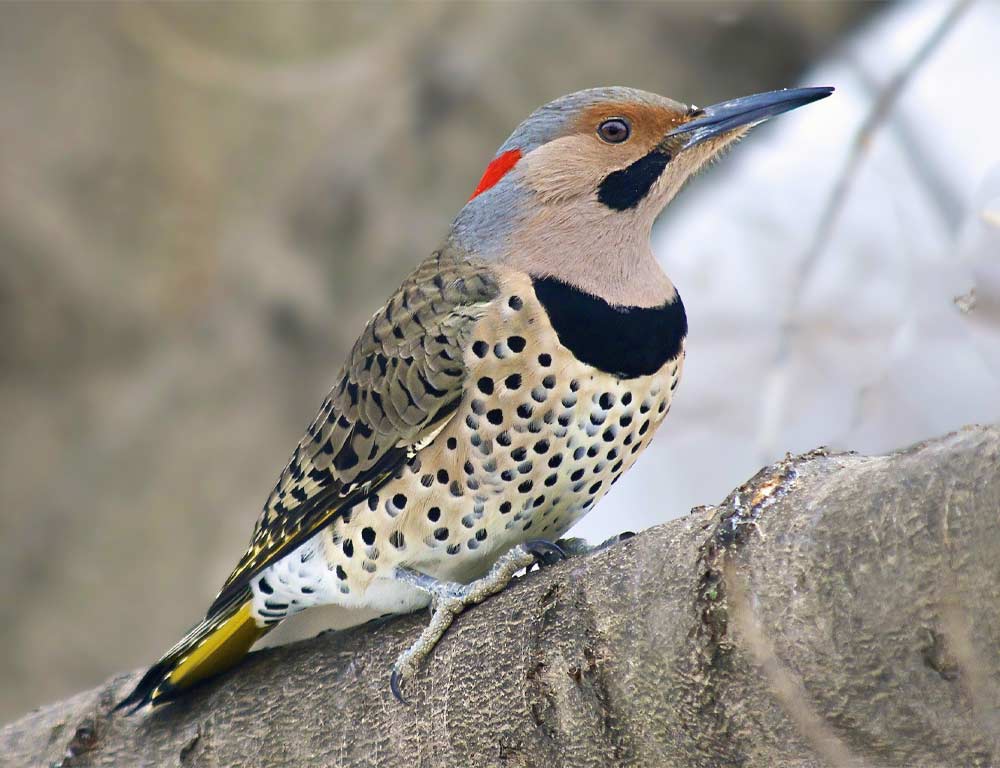
- Scientific Name: Colaptes auratus
- Population: Stable
- Life Span: Up to 9 years
- Size: 11-14 inches
- Weight: 3.9-5.6 ounces
- Food: Insects, ants, berries
- Wingspan: 17-21 inches
- Status: Least Concern
The Northern Flicker, a striking woodpecker with a distinctive spotted appearance, graces Maryland’s woodlands with its vibrant plumage.
Their populations remain stable, and they are known for their ground-feeding habits, often seen foraging for insects and ants. Northern Flickers are efficient flyers with a size ranging from 11-14 inches and an impressive wingspan of 17-21 inches.
Their diet includes a variety of insects, particularly ants, which they extract from the ground using their long bills. Berries also supplement their diet, showcasing their adaptability.
These woodpeckers often utilize tree cavities for nesting, contributing to the overall biodiversity of Maryland’s ecosystems. Their unique drumming patterns and calls make them distinguishable in the avian chorus of the state.
6. Yellow-bellied Sapsucker
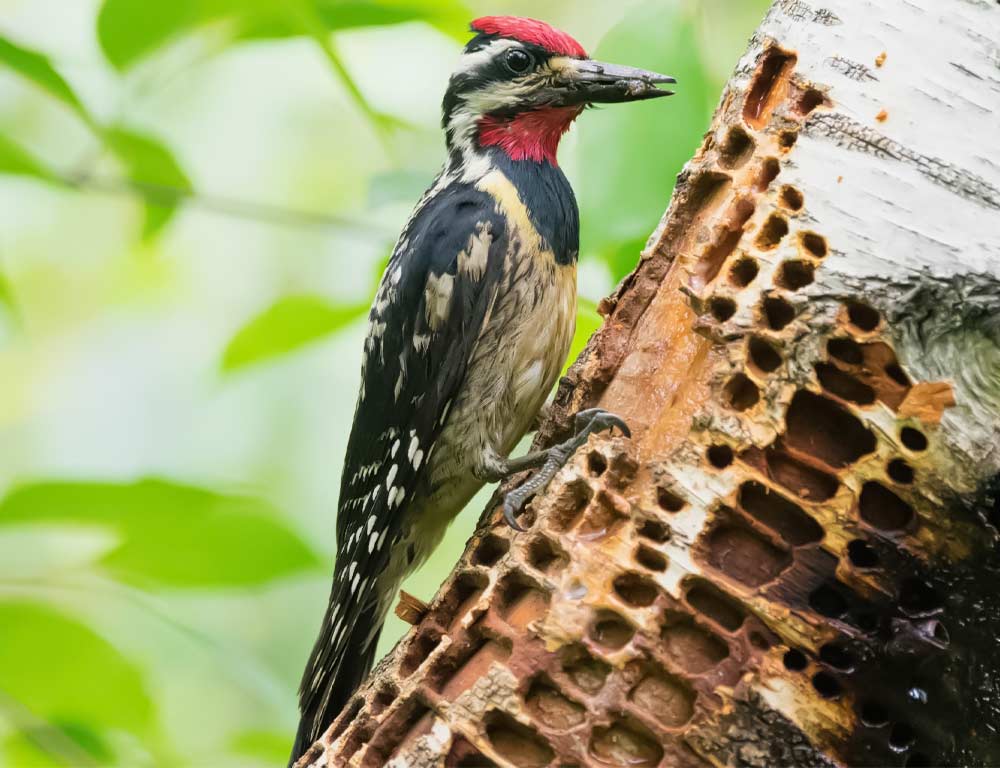
- Scientific Name: Sphyrapicus varius
- Population: Stable
- Life Span: Up to 9 years
- Size: 7.1-8.7 inches
- Weight: 1.5-2.4 ounces
- Food: Sap, insects, berries
- Wingspan: 13-16 inches
- Status: Least Concern
The Yellow-bellied Sapsucker, named for its distinctive yellow belly, is a unique woodpecker species residing in Maryland’s woodlands. With a stable population, these birds have adapted to a specialized diet, including sap, insects, and berries.
Measuring 7.1-8.7 inches with a wingspan of 13-16 inches, these woodpeckers are characterized by their black and white plumage, red forehead, and yellowish belly.
Their feeding behavior involves drilling rows of small holes in tree bark to extract sap, which attracts insects, serving as a valuable food source.
Yellow-bellied Sapsuckers play an essential role in their ecosystem by creating sap wells, benefiting themselves and providing nourishment to other birds and insects.
Their nesting sites are often in tree cavities, demonstrating their reliance on mature trees. Observing these woodpeckers in Maryland reveals their role in the delicate balance of the state’s natural environments.
How to Preserve Woodpeckers of Maryland?
Preserving woodpeckers in Maryland involves a combination of habitat conservation, awareness, and responsible human practices. Here are several ways to contribute to the preservation of woodpeckers in the state:
Habitat Protection
Support and participate in efforts to conserve natural habitats and forested areas where woodpeckers thrive. These areas should include a mix of mature trees for nesting and foraging.
Tree Conservation
Protect and preserve mature trees, which are crucial for woodpeckers, providing nesting sites and foraging opportunities. Avoid unnecessary tree removal in areas frequented by woodpeckers.
Limit Pesticide Use
Minimize the use of pesticides and herbicides, as these chemicals can harm the insects that woodpeckers depend on for food. Opt for environmentally friendly and sustainable landscaping practices.
Provide Nesting Sites
Install woodpecker-friendly nesting boxes in suitable locations. These artificial nesting sites can supplement natural tree cavities, especially in areas where mature trees are scarce.
Promote Native Plants
Encourage planting native trees and plants that attract insects, forming a natural food source for woodpeckers. Native vegetation supports a healthy ecosystem.
Educate the Public
Implement educational programs to raise awareness about the importance of woodpeckers in the ecosystem. Promote responsible birdwatching and photography practices to minimize disturbance.
Monitor Woodpecker Populations
Support and participate in research and monitoring programs focused on woodpecker populations in Maryland. Understanding population dynamics helps guide conservation efforts.
Support Conservation Organizations
Contribute to or volunteer with local and national conservation organizations working to protect bird habitats. Financial support aids in research, habitat restoration, and educational programs.
Responsible Recreation
If engaging in outdoor activities, practice responsible recreation by minimizing disturbance to woodpecker habitats. Follow designated trails and avoid disturbing nesting sites.
Advocate for Legislation
Advocate for policies that protect wildlife habitats and biodiversity. Engage with local and state authorities to ensure that woodpecker-friendly practices are considered in land-use planning.
Preserving woodpeckers in Maryland requires a collective effort from individuals, communities, and organizations.
By adopting these practices, residents and nature enthusiasts can contribute to the conservation and sustainability of woodpecker populations in the state.
Wrapping Up
Maryland’s woodpeckers play a vital role in the state’s ecosystems, contributing to biodiversity and ecological balance.
With their diverse species, from the iconic Pileated Woodpecker to the vibrant Red-headed Woodpecker, these birds thrive in Maryland’s rich and varied landscapes.
Conservation efforts, habitat protection, and responsible practices are crucial to preserving these feathered residents.
Whether in natural woodlands or suburban areas, the resilience and adaptability of woodpeckers serve as a testament to the delicate interplay between nature and human stewardship.
By fostering awareness, supporting conservation initiatives, and embracing sustainable practices, we can ensure a harmonious coexistence with Maryland’s woodpecker populations, safeguarding their habitats for future generations.